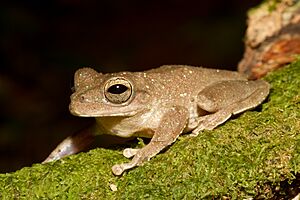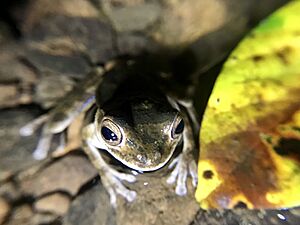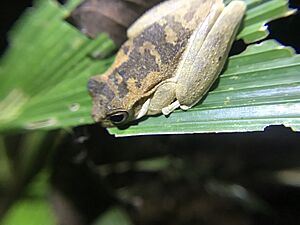Panama cross-banded tree frog facts for kids
Quick facts for kids Panama cross-banded tree frog |
|
|---|---|
 |
|
| Conservation status | |
| Scientific classification | |
| Synonyms | |
|
Hyla sila (Duellman & Trueb, 1966) |
The Panama cross-banded tree frog or pug-nosed tree frog (Smilisca sila) is a type of frog from the Hylidae family. You can find it in the wet, low areas of southwestern Costa Rica to eastern Panama. It also lives in the lowlands of Panama and northern Colombia. Male frogs call together at the same time to hide from animals that might eat them. Female frogs build small pools during mating and lay their eggs on the water's surface.
Contents
About the Panama Cross-Banded Tree Frog
Males of this frog grow to about 45 mm (1.8 inches) long. Females are larger, growing up to 62 mm (2.4 inches) long. Their skin is a bit bumpy. They can be gray, tan, or reddish-brown on their backs. They might also have white or green spots, or darker blotches. Their bellies are creamy white.
Male frogs have a gray vocal sac, which is a pouch under their chin that helps them make calls. Females have a white vocal sac with brown spots. The underside of their thighs and groin are brown with blue spots. The underside of their arms has yellow spots. Their eyes have brown irises with a black net-like pattern. Their toes are webbed on both front and back legs. They also have large pads at the tips of their toes.
Young S. sila frogs, called tadpoles, are quite round. They have weak muscles and short, wide tails. These features help them live in small ponds. Their mouths are made for scraping and chewing food.
Where They Live and What They Like
You can find Smilisca sila in the lowlands of southwest Costa Rica, Panama, and northern Colombia. These frogs like areas where wet and dry tropical forests meet. They prefer places close to shallow, rocky pools and stream banks. You can also find them in forests that have grown back after being cut down. Sometimes, they even live in open areas.
These frogs live at elevations between 10 and 970 meters (about 33 to 3,182 feet). They usually breed during the dry season, from January to April, in lower areas. In higher places, they might breed during the rainy season. Female frogs like to lay their eggs on gravel islands or banks next to small streams. Male frogs tend to call near streams where there is other noise and plants hanging over. This helps them hide their calls from predators and find cover if needed. Tadpoles live in clear pools and slow-moving water, usually near the bottom.
Protecting the Panama Cross-Banded Tree Frog
The IUCN Red List currently lists this species as "Least Concern." This means they are not in immediate danger of disappearing. They were last checked in 2019.
Even though they are not highly endangered, these frogs still face threats. Like many amphibians, they can be harmed by habitat loss. This happens when their homes are destroyed by farming, illegal crops, pollution, pesticides, logging, and new human settlements. Luckily, Smilisca sila lives in many protected areas. These include the Parque Nacional Carara in Costa Rica and Barro Colorado Island in Panama.
Frog Family and Relatives
The closest relatives of Smilisca sila are other Smilisca species. These include the S. baudinii, S. manisorum, S. phaeota, S. puma, and S. sordida.
S. sila and S. sordida both build special basins for their eggs. This unique way of reproducing is not seen in other Smilisca species.
How They Behave
What They Eat
S. sila tadpoles eat algae and plant matter found in their ponds. They have mouths designed for scraping food. Even though these frogs breed in the dry season, rain can sometimes connect small ponds. This allows tadpoles to move between ponds and find more food.
Hiding Their Calls
Frogs often communicate by making sounds. Male S. sila frogs use calls to attract females. However, animals that hunt frogs, like the frog-eating bat (Trachops cirrhosus) and frog-biting midges (tiny flies called Corethrella spp.), also listen for these calls to find their prey. This means male frogs have to balance attracting a mate with avoiding predators.
Male S. sila frogs tend to call more often and make more complex calls on moonlit nights. They also call for longer periods. This is because they can see predators better when it's bright. On dark, moonless nights, males often hide in plants. They make shorter, simpler calls less often.
Calling Together
Male S. sila frogs also do something unusual: they call almost perfectly at the same time. Most other frog species take turns calling. When these frogs call together, it creates an auditory illusion. Predators tend to focus on the very first call they hear. They then think all the following calls are coming from the same spot as the first one. This helps the other males hide their true location from predators.
Calling together might make it harder for males to attract a female. However, female S. sila frogs do not prefer the first caller. They might even use this illusion to choose hidden males. This helps them avoid being caught by predators themselves. In fact, females being less picky about who calls first helped this hiding strategy develop. Females also don't seem to care if the calls are synchronized or not.
Mating and Reproduction
How Males Call for Mates
Panama cross-banded tree frogs are active at night. They breed during the dry season. Males call from the edges of forest streams. Male S. sila frogs use different types of complex calls to attract females. Their calls change depending on things like if predators are nearby, if other males are calling, the noise around them, and how dark the night is.
The calls males make to attract mates are complex. They have at least two different notes and a big change in pitch during the call. This type of call is rare among frogs. The main pitch of S. sila calls is 1915 Hz. A single note from a male's call lasts about 0.16 seconds. Calls can have up to four notes. On average, a male makes about 1.7 calls per minute. Males do not gather in groups along streams. Instead, they are spread out evenly.
Frogs often have special body parts and ways their bodies work to control the sound and vibrations of their calls. Common features for calling frogs include strong body muscles, vocal sacs, and eardrums. Calling takes a lot of energy. This might explain why frog choruses and songs are usually short.
Mating and Laying Eggs
Female S. sila frogs build single basins (small pools) on gravel islands in streams or along riverbanks. They build these basins during mating. While the male holds onto the female, she uses her back legs to dig out a water-filled dip. This can take about 40 to 160 minutes.
After building the basin, the female arches her back out of the water. She then lays her eggs, which the male fertilizes. Finally, she lowers her back into the water. The small, black, fertilized eggs slide off her back and float in the basin. Building basins for reproduction is rare among frogs. Only about 15 out of over 5100 frog species do this. It's even rarer for the female to build the basin during mating. Only S. sila and its close relative S. sordida do this. All other Smilisca species lay their eggs as a film that floats on the surface of standing water.
These open basins might be warmer than the stream water. This could help the young grow faster. They also offer safety from water predators like fish. However, the basins can still be affected by parasites like planarians, other tadpoles eating the eggs, drying out, and floods. The success of the eggs in the basin depends on where predators are and when the eggs are laid.
Dangers from the Environment
Predators
S. sila frogs are often hunted by the Trachops cirrhosus, also known as the frog-eating bat. They are also preyed upon by Corethrella spp., which are frog-biting midges. The frog-eating bat flies along streams and catches frogs it hears calling. After catching a frog, the bat eats it whole. Frog-biting midges drink the frogs' blood. They can also spread blood parasites. Both of these predators use the male frogs' calls to find them.
Parasites
Adult S. sila frogs can get blood parasites from frog-biting midges. S. sila eggs and tadpoles can be harmed by water parasites like planarians and Girardia sp. These parasites can get into the jelly around the eggs and eat them.
Another group of midges that parasitize S. sila are Corethrella spp. These midges can follow the mating calls of many different frog species, including S. sila. This ability helps them find hosts easily and move between them, which helps them survive. The better the parasite survives, the more dangerous it is for the S. sila frog.





